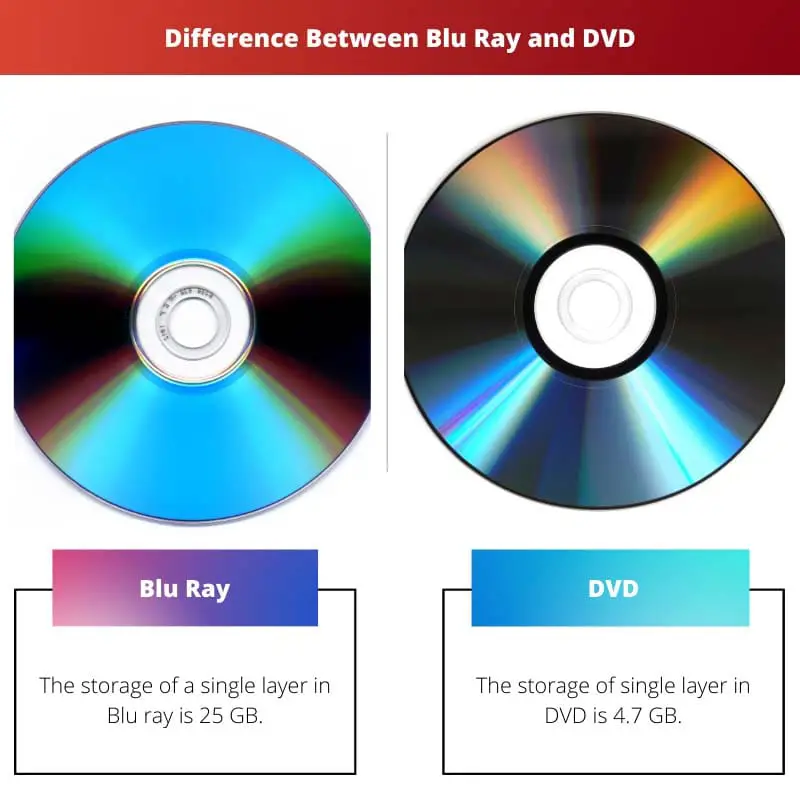The new generation of contemporary technology is data producers. Not at a low rate. This generation is producing the data just like a factory with no break.
Some data can be relevant and important to an individual but waste for others. So, to store all that data, many storage devices are available in which Blu-ray and DVDs are also included.
They have different features which make them unique and provide different services to fulfil everyone’s purpose.
Key Takeaways
- Blu-ray discs have higher storage capacity than DVDs, providing better quality video and audio.
- Blu-ray players can also play DVDs, but DVD players cannot play Blu-ray discs.
- Blu-ray discs are more expensive than DVDs due to their advanced technology.
Blu Ray vs DVD
Blu-ray disc types can store 25 GB of data on a single layer. It delivers high-definition picture quality with 1080HD capabilities. Blu-ray discs are more expensive than DVDs. In contrast, 4.7 GB of data can be stored on a typical DVD. The image quality on DVDs is significantly less at 480SD.

Blu-Ray is a storage device that is bigger than many storage devices. It is an HD storage device which makes it unique and different from many other optical storage devices.
It is preferred and produced for high-definition videos. The capability of Blu-ray of storage is greater than other disk format devices.
The term DVD is referred to as Digital Versatile Disk. DVD is the disk that is utilized using videotape recorders. It is also a storage device produced for videos which is capable of storing 7 times the normal CDs.
They can also be operated on computers.
Comparison Table
| Parameters of Comparison | Blu Ray | DVD |
|---|---|---|
| Storage | The storage of a single layer in Blu ray is 25 GB. | The storage of single layer in DVD is 4.7 GB |
| Location of the metal layer | The layer mater or the recording layer’s position in the Blu ray is near to the reading mechanism’s objective lenses. | In DVD’S, the layer of recoding or the metal layer is positioned in the middle of the disk. |
| Spacing between spiral loops | The space between the spiral loops in the Blu ray is 0.30 micrometers. | The spacing between the spiral loops of DVD is 0.74 micrometer which is more as compared to Blu-ray. |
| Spacing between the pits | The space between pits of Blu ray is 0.15 micrometer. | The space between pits of DVD is 0.4 micrometer. |
| Correction codes | The correction codes used in Blu ray are picket codes. | The correction codes used in DVD are RS-PC and EFMplus. |
What is Blu Ray?
Blu ray is known as a storage device that is bigger than many storage devices. It is an HD storage device which makes it unique and different from many other optical storage devices.
It is preferred and produced for high-definition videos. The capability of Blu-ray of storage is greater than other disk format devices.
The storage of a single layer in Blu ray is 25 GB which is much greater than other disk storage devices. The layer mater or the recording layer’s position in the Blu ray is near to the reading mechanism’s objective lenses.
The space between the spiral loops present in the Blu ray is found to be 0.30 micrometres. The space between the pits of Blu ray is 0.15 micrometre. The correction codes used in Blu ray are picket codes.
The wavelength in the Blu ray is 405 nm in laser. The rate of speed by which the data is transferred from a Blu ray is 36 MB/sec.
The size with the presence of a double layer concerning Blu ray is 50 GB which is a huge storage capability to store a lot of data and files.
It is easily available and costs more expensive than the DVD but provides more storage at that price which makes it a genuine product for common people.

What is DVD?
The full form of the DVD is Digital Versatile Disk. DVD is the disk that is utilized using videotape recorders.
It is also a storage device produced for videos which is capable of storing 7 times the normal CDs. They can also be operated on computers.
The storage of a single layer in DVD is 4.7 GB. In DVD, the layer of recoding or the metal layer is positioned in the middle of the disk.
The spacing found between the spiral loops present in the DVD is 0.74 micrometres which is more as compared to Blu-ray. The space between the pits of the DVD is 0.4 micrometres.
The correction codes used in DVD are RS-PC and EFMplus. DVD’s laser wavelength value is 650 nm, and the data transfer rate is 11MB/sec, which is very less than Blu-ray in comparison.
The double layer of DVD provides the size of 8.5 GB, which can store a genuine number of files for storage and transportation. It is easily available and cost cheaper than the Blu ray which makes it affordable for common people.

Main Differences Between Blu Ray and DVD
- The storage capacity in a single layer that belongs to Blu-ray is 25 GB. In contrast, the storage capacity in a single layer which belongs to Digital Versatile Disk, is 4.7 GB.
- The layer of metal or the other layer of recording layer’s respective position present in the Blu ray is closer to the mechanism of reading objective lenses, whereas in DVD, the layer of recoding or the other, which is the metal layer, is present in the middle of the disk.
- The space between the spiral loops in the Blu ray is 0.30 micrometre, whereas the spacing between the spiral loops of the DVD is 0.74 micrometres which is more as compared to Blu ray.
- The space between the pits of Blu ray is 0.15 micrometre, whereas the space between pits of DVD is 0.4 micrometre.
- The correction codes used in Blu ray are picket codes, whereas the correction codes used in DVD are RS-PC and EFMplus.

- https://www.tandfonline.com/doi/abs/10.1080/00076791.2013.771332
- https://pubs.acs.org/doi/abs/10.1021/acssensors.8b00340
- https://papers.ssrn.com/sol3/papers.cfm?abstract_id=1626224
- https://www.sciencedirect.com/science/article/pii/S0925400519300504
- https://www.tandfonline.com/doi/abs/10.1080/08997764.2010.527206


